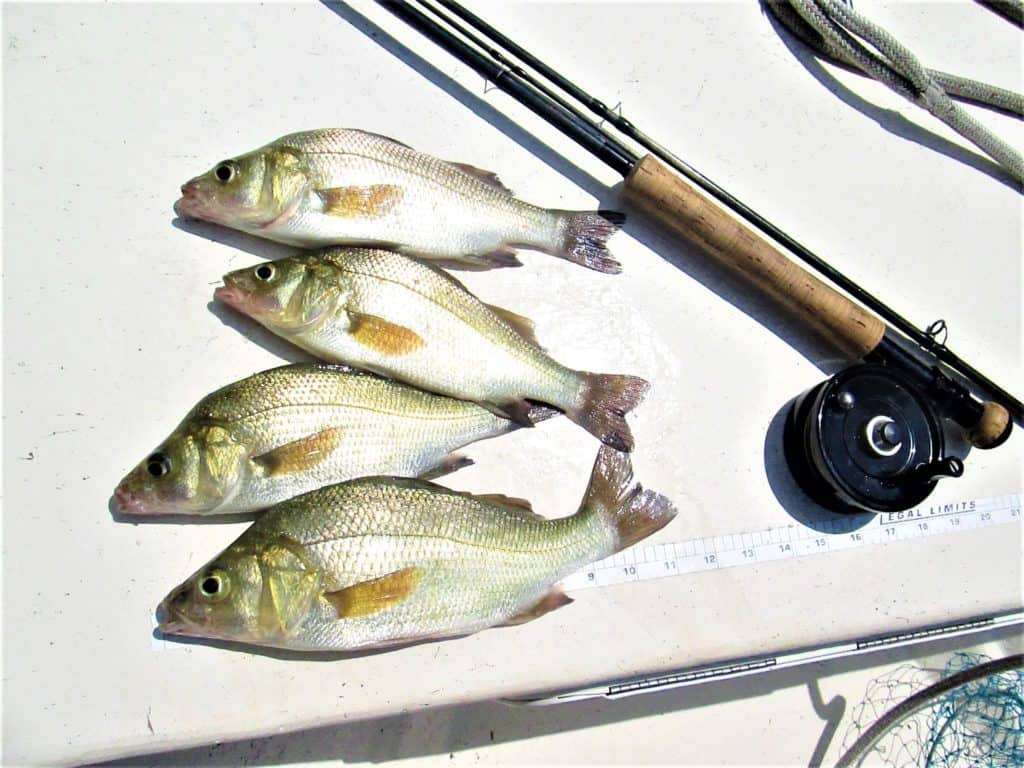Sporting Life

White Perch on the Fly Rod
The sun was coming up, the wind was still and I suddenly realized I was missing a special opportunity. The evening before I had just repositioned one of my favorite Bay fly rods on its rack and anointed the line with some line dressing but I had no plans to use it soon—and that was a mistake.
The rockfish season is lackluster this year but white perch is another matter. If you’re willing to put some search time in to find decent-sized fish in shallow water, there are definite possibilities. One must, however, use prudence in harvesting the beasties once you’ve located them.
White perch are an eager feeder and with the right tackle a school of sizeable fish can be easily depleted, especially with repeated efforts on subsequent days. Once reduced in numbers, you’ll not find the bigger fish being replaced anytime this season.
If, however, you only keep what you need for the next day or so (“House guests and fish begin to stink within three days,” said Ben Franklin) you can work that school again and again, well into the season. Two 10-inch fish provide four fat fillets which translates into eight to 10 finger-sized chunks for a fry-up. That’s generally enough for one ravenous adult, especially when served with some Eastern Shore silver queen corn.
In contrast, I can distinctly remember comments by naive anglers on more than one occasion that went something like, “I don’t know what’s happened, they’re gone. But we got 60 nice perch here day before yesterday!”
Their numbers, unfortunately are finite. Once you’ve hammered a school thoroughly, those remaining will move out and be much more difficult to locate. Yes, it’s hard to hold back when the bite is hot, but it’s worth your patience.
Which is where the fly rod comes into its own. It has a harvest limit built into its operation. You have to know an area and the species to effectively catch many fish. The task with the long rod will be more challenging, but frankly, any nice perch on a fly rod is worth 10 jerked out of the water on live bait or spinners.
An 8- to 9-foot, 8-weight rod is not too much for perch; it’s easy to cast that mid-weight rig a good distance, even with weighted flies. You’ll be surprised how a 10- or 11-inch perch will threaten your demeanor with the outfit. Lighter, shorter, trout class rods will be sportier but the larger streamer flies needed for perch can make casting a challenge
The feeding habits of the white perch necessitate a close to the bottom presentation and a weighted fly is a definite advantage. The best streamers will be Clouser minnows or one of their many clones in size four to size two. Chartreuse is always good as is white, olive or combos of those colors.
Floating lines will work well as long as the depths you are searching are 4 feet or less, if you’ve decided to fish deeper, an intermediate line or a sink tip will give you a better advantage. Keep your leaders to 6 feet or less in the 6- to 10-pound class with all types of lines and use a loop knot to connect the fly for maximum action down below.
Remember to throw an elliptical backcast with the Clousers and keep a simple, long handled net handy because the extra length of a fly rod will make landing the big ones a bit more difficult. However, the extreme flexibility of the rod will also mean less fish are lost from pulled hooks.
Once you’ve become reliably successful with catching white perch with flies, you might become addicted to the long rod for everything on the Chesapeake. And if you’re anything like me, you’ll also discover that any fish caught on a fly tastes better on the table.
*****
Fishfinder:
The July heat wave has brought bath water temps to the Bay. When the water gets this warm it’s best to avoid mid-day hours altogether. Rockfish are particularly vulnerable in these conditions and catch and release mortality approaches an unfortunate certainty above 90 degrees. Think snakeheads, bluegills, bass and white perch right now and even then, the first light/last light parts of the day will be the most productive. Crabbing remains somewhat productive but early and late are the keys here as well.
